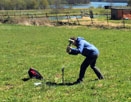Services
Solutions
Fulltext
Krásno-Koník: The definition of a new tin and lithium ore deposit in Western Bohemia
Type of project: Private project
Investor: KMK Granit, a.s., Krásno
Implementation period: 2011-2012
Activities:
- Research of archival data
- Completing of conditions of exploitability
- Determination of prospected reserves of lithium and tin-tungsten ore according the Czech Mining Act No 44/1988
The aim was to evaluate of archival data and define a new deposit of Sn and Li ores in mining district of Horní Slavkov-Krásno in the Slavkovský Lest Mts. (Western Bohemia). The mineralization is developed in the endocontact of the granites of the young intrusive complex of the Karlovy Vary Massif with crystalline rocks of the Horní Slavkov unit built by migmatites, paragneises and orthogneises.
In the deposit area, three types of granite are reported:
- fine- to medium-grained biotite granite of the Čistá type - light grey, greenish-grey to yellowish-white, predominantly epigranular, sometimes with feldspar phenocrysts up to 2 cm and quartz grains up to 1 cm;
- fine- to medium-grained biotite granite of the Čistá type - light grey, white-grey to yellowish, often porphyritic (feldspar up to 4 cm, quartz up to 0.5-1 cm), from previous one differs practice only by the grain size, showing mutual transitions;
- alkali feldspar (albite) granite occurs in the NE of the area, where the feldspar raw material is quarried; probably the same rock was documented as “fine-grained feldspatite” in a half meter layer in the borehole KR20.
In the vicinity of the contact, the granites are strongly autometamorph and pneumatolytic changed. Biotite and potassium feldspar are replaced by lithium mica, muscovite and quartz to form greisenized granites to greisens.
Towards to the deep, greisen pass into sericitized and kaolinized granite and to the unconverted rock. The shape of the greisenized zones generally follows the intrusion contact. Altered granite is penetrated by younger, mostly steep cracks and quartz veins with hydrothermal filling.
The Krásno-Koník deposit is formed by medium- to coarse-grained mica greisen of a grey colour, composed of quartz, lithium mica (polylithionite) and subsidiary (but always present) topaz. From the ore minerals are present cassiterite in macroscopic aggregates and fine impregnations and, less often wolframite, rare chalcopyrite. Greisen is also permeated by steep cracks with hematite or limonite pigment. Locally appear mica accumulations and relicts of undecomposed feldspar. Macroscopic cassiterite was observed also in quartz veins, its thickness ranges from a few mm to 1 cm. Locally appear fluoritization and kaolinization.
The greisen tin ore resembles the ore mined in the past on the "main" deposit of Krásno. The main component is tin in the form of cassiterite. Over 95% tin is bound to aggregates greater than 0.25 mm.
Wolfram bound to wolframite was determined only in a subsidiary, uncommon in comparison to other deposits in the district. The highest contents reported in samples from the survey in 1961 are around 0.05% W, from the works in 1968 from traces to 0.32%.
Significant is the content of lithium, bond primarily in zinnwaldite and Li-muscovite mica.
From sulphides is reported mainly chalcopyrite, again in very low quantity (Cu content in the individual samples max. 0.2%). Chalcopyrite is enriched by indium (Fiala and Pácal 1961), but in economically unusable volume. Other rarely observed sulphides are sphalerite and kesterite (Janečka and Just 1968). Kesterite – if occurred at higher contents - could reduce the effectiveness of gravitational processing (tin sulphide).
A macroscopic arsenopyrite was not observed. Minimum contents are even in the case of molybdenite (under thousandths% Mo) and native bismuth (max. 0.01% Bi).
Decomposed lithium rich granite was already in the middle of the last century regarded as the raw material of the future (cf. Fiala and Pácal 1961). Medium Li2O contents in the rock range from 0.20 to 0.25%. Lithium mica is present also in some types of greisens and greisenized granites.
Possible applications of lithium mica from the Krásno-Koník deposit in the glass and ceramics industry are complicated by higher content of colouring oxides (mainly Fe) in the crystal lattice. On the contrary, the iron content in zinnwaldite allows convenient treatment using electromagnetic separation.
The mineral composition of greisen tin ores according Janeček and Just (1968):
| Mineral | mica-quartz greisen | quartz-mica greisen | mica greisen* |
| Li-mica | 42.2 % | 45.8 % | 98.0 % |
| quartz | 57.5 % | 40.0 % | 0.9 % |
| topaz | 0.2 % | 0.2 % | 1.0 % |
| sericite | 0.1 % | 0.1 % | 0.1 % |
)* in mica extremely enriched rock
The deposit is located within the mining area where fundamental conflicts of interest are resolved. It is located in the CHOPAV (Protected Area of Natural Water Accumulation) “Cheb basin and Slavkovský Les”, in the zone IV of the CHKO (Protected Landscape Area) “Slavkovský Les”. In the southeast of the deposit lies the Natura2000 site "Krásenské Rašeliniště" (code CZ0410401).
The Krásno-Koník is a small-scale and low-grade deposit obtaining of less than 200 kt Sn ore with an average content of 0.25% Sn and over 1700 kt lithium ore of 0.118% Li. According to Czech legislation (Mining Act No 44/1988), the calculated reserves are classified as “prospected non-extractable”. For the future will be necessary:
- to specify areal and the depth extent of the deposit, particularly in the case of lithium ore;
- to solve complex processing of tin and lithium ore;
- to solve sale possibilities of obtained concentrates;
- to extend the available reserves of tin ore including of other localities in the region.


















